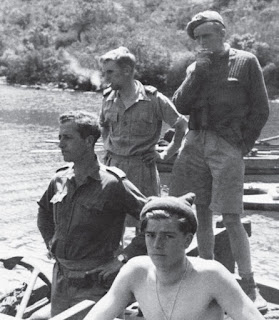 |
| Pilot Sotiris Skanziklas, Royal Hellenic Air Force. Photo web |
Sotiris Skanziklas
Sotiris or Nick as he was known to his fellow prisoners was 22 years old at the time of the escape.
We don’t know much about Nick’s background and early war service. What we do know is that he was a Pilot with the Royal Hellenic Air Force and by 1944 was imprisoned along with other Allied airmen in Stalag Luft III at Sagan (modern day Zagan, Poland).
Fellow escaper Jimmy James wrote of Sotiris as a cheerful soul. Another inmate – New Zealand RAF Pilot Bill Hickson – who helped in the escape but didn’t take part in the actual breakout recorded that Nick was his room-mate and friend.
The Escape
Sotiris was asked to team up with British RAF Squadron Leader Bertram “Jimmy” James, MC. They planned to make their way down the Danube Valley to Greece and from there on to Turkey and Allied lines in the Middle East. But they would not make it.
Along with the other escapers, Sotiris made his escape on the night of 24th March 1944. He would have made his way along the 365-foot long tunnel constructed by the prisoners and out into the cold, fresh air. He was wearing a cut-down, dyed overcoat and cloth cap – Jimmy James thought he looked like a Greek worker. They were part of a larger group of 12 escapers who were to pass as foreign labourers from a local timber mill on their way home to Czechoslovakia on leave. They would hopefully then make contact with the local resistance. They were known as the wood mill party.
Jimmy James has described the route and experience of both as they tried to make their way to freedom. After a train trip had taken them 100 miles from the camp, Sotiris and Jimmy walked through wooded mountains covered in snow as they made their way to reach the Czech border. The weather was cold and they were wet through. Jimmy records that Sotiris was shivering and blue with the cold. Sotiris told Jimmy that they still had about 40 miles to get to the border. They made their way to Hirschberg and its railway station. As they approached the ticker office they were confronted by German police and both arrested.
Three of the original 76 escapers made it to freedom – two Norwegians and a Dutchman.
The Reckoning
Jimmy was eventually transferred to Sachsenhausen Concentration Camp along with 7 other escapers, 15 others being returned to Stalag Luft III.
But Nick would face another terrible fate. 22 year old Sotiris was taken to Gorlitz prison, east of Dresden. From here he was taken to a place of execution. He was one of the 50 escapers executed by the Gestapo in March 1944. 7 others in his original escape party of 12 were also executed. The record from Nuremberg war crime proceeding relating to the murderers states:
"Flight Lieutenants Wernham, Kiewnarski, Pawluk, and Skanziklas. On or about the 26th of March 1944 these officers were interrogated at the police station in Hirschberg and were then moved to the civil gaol in that town. On the morning of 29th March Pawluk and Kiewnarski were taken away and later in the day Skanziklas and Wernham left. Both parties were escorted, but their destination was unknown. They have not been seen since and the urns later received at the Stalag showing their names bear the date 30th March 1944."
He was the only Hellene amongst 18 other nationalities (including 5 Australians and 2 New Zealanders) who were murdered.
The ashes of most of the escapers were returned to the POW camp, where a memorial now stands.
Sotiris’ name is listed amongst the names of the other murdered escapers on this memorial.
 |
| Memorial to the 50, Zagan. Photo wikipedia |
If anyone knows more about Sotiris and his story I'd love to hear about it.
Lest we forget
Jim Claven
Secretary
Lemnos Gallipoli Commemorative Committee
















